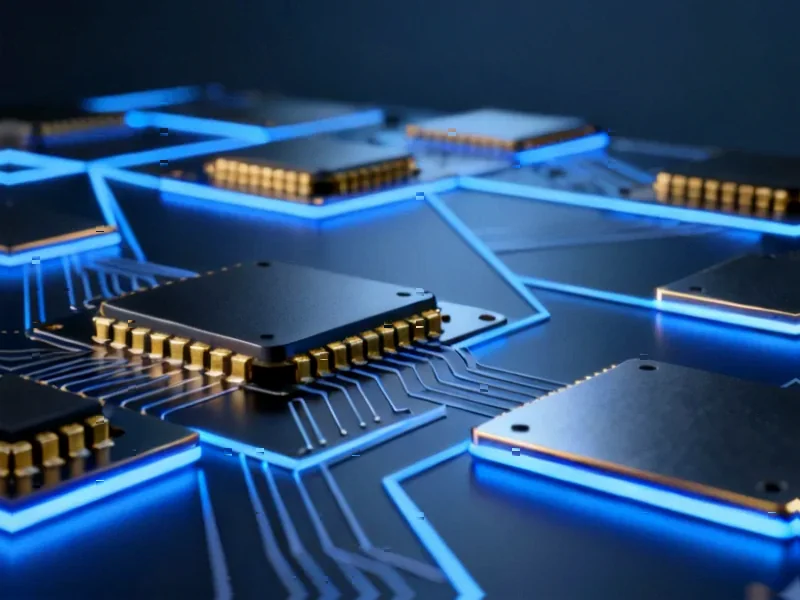Breakthrough Performance Claims
Israeli chip startup NextSilicon has disclosed architecture and performance details for its Maverick-2 accelerator, with reports indicating it can outperform GPUs from Nvidia and CPUs from Intel. According to the company’s announcement, the Maverick-2 represents what sources describe as the world’s first Intelligent Compute Accelerator (ICA), featuring a novel computing architecture designed specifically for high-performance computing artificial intelligence (HPC-AI) applications.
Table of Contents
Energy Efficiency Advantages
Benchmarks published by NextSilicon suggest remarkable energy efficiency improvements compared to established industry leaders. Based on internal testing and publicly available power and performance information, analysts indicate the Maverick-2 delivers 4x the performance-per-watt compared to the Nvidia HGX B200 GPU for FP64 operations, and more than 20x performance-per-watt than the Intel Xeon Sapphire Rapids CPU for FP64 calculations. The report states that total energy costs for Maverick-2 are reportedly less than half those of Nvidia’s HGX B200 solution.
Performance Benchmark Results
In specific testing scenarios, sources indicate NextSilicon’s ICA achieved impressive results. For AI inferencing, the accelerator reportedly reached 32.6 GUPS (Giga-Updates Per Second) at 460 watts, described as 22x faster than CPUs and almost 6x faster than GPUs. For HPCG (High-Performance Conjugate Gradients) benchmarks, the technology was reportedly comparable to leading GPUs, achieving 600 gigaflops at 750 watts while consuming half the power according to the company’s claims.
Architectural Innovation
NextSilicon founder and CEO Elad Raz explained the fundamental shift in design philosophy. “For eight decades, rigid hardware designs have forced software to adapt, with modern CPUs dedicating roughly 98 percent of silicon to overhead and just two percent to actual computation,” Raz stated. “Maverick-2 flips this paradigm on its head by devoting the majority of hardware real estate to compute, moving runtime overhead management to intelligent algorithms and software in real-time through our dataflow architecture.”, according to technological advances
Technical Specifications
Built on TSMC’s 5nm process technology, the Maverick-2 ICA is available in two configurations according to reports. The single-die PCIe format features 96GB of HBM3e memory with maximum power consumption of 300W, while the dual-die Open Accelerator Module (OAM) offering contains 192GB of HBM3e with maximum power consumption of 600W.
RISC-V Strategic Direction
Alongside the Maverick-2 details, NextSilicon announced development of Arbel, a new RISC-V test chip that will also utilize TSMC’s 5nm process. The startup claims the chip “surpasses current RISC-V competition, as well as Intel LionCove and AMD Zen 5,” though independent verification of these claims is not yet available.
Company statements indicate that choosing RISC-V over Arm architecture was a strategic decision representing “a fundamental shift toward an open and adaptable future” that will allow the startup to develop its own patented IP from the ground up. No release date for Arbel has been disclosed, with additional benchmark details expected as the project progresses beyond the test-chip phase.
Market Implications
According to industry observers, NextSilicon’s technology could potentially disrupt the current HPC-AI accelerator market if their performance claims are validated in real-world deployments. The company, founded in 2018, has raised more than $200 million across four funding rounds from investors including Third Point Ventures, Playground Global, Aleph, and Amiti Ventures.
Raz emphasized the long-term vision, stating: “As AI and HPC workloads evolve, Maverick-2’s intelligent, adaptive design ensures our customers’ investments remain future-proof while delivering unparalleled performance today. With its pioneering dataflow architecture already transforming computing, and Arbel showcasing our ability to engineer world-class, general-purpose silicon, we’re setting a bold new standard for what’s possible.”
Related Articles You May Find Interesting
- Samsung Enters Mixed Reality Arena with $1799 Galaxy XR, Challenging Apple’s Vis
- UK Regulators Push for Major App Store Overhauls at Apple and Google
- Beyond the Hype: Unpacking Apple’s M5 Chip Evolution in the Context of Its Prede
- UK Regulators Challenge Tech Titans: App Store Overhaul Could Reshape Mobile Eco
- WhatsApp Severs ChatGPT Integration: 50 Million Users Face January 2026 Deadline
References & Further Reading
This article draws from multiple authoritative sources. For more information, please consult:
- http://en.wikipedia.org/wiki/RISC-V
- http://en.wikipedia.org/wiki/Hardware_acceleration
- http://en.wikipedia.org/wiki/Nvidia
- http://en.wikipedia.org/wiki/Central_processing_unit
- http://en.wikipedia.org/wiki/Graphics_processing_unit
This article aggregates information from publicly available sources. All trademarks and copyrights belong to their respective owners.
Note: Featured image is for illustrative purposes only and does not represent any specific product, service, or entity mentioned in this article.



